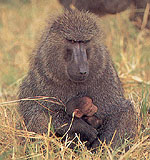OLIVE BABOON

How to Recognize
Olive baboons are large monkeys with short, broken-looking tails, and a bare dog-like muzzle. Mature males have a thick, erectile mane and gray cheeks. They may become pests when visiting campsites for hand-outs. They will then become dangerous and will be destroyed, so it’s important to never feed them. There are two types in East Africa – Yellow Baboon and Olive Baboon (we only saw the olive baboon).
Habitat
Baboons are widespread and can be found in woodland, savanna, forest, and cultivated land. They are very adaptable but always need to be by water.
Behavior
Diurnal with erratic daily patterns. Their day consists of rising late, retiring early, grooming, and foraging. They live in complex troops numbering between 8 and 200. There is no single dominant male, as the males band together to defend a troop. Once males become sexually mature, they will transfer to another troop or form loose associations.
Females and their young form the core of a group, and stay in it for life unless the troop subdivides. Female rank is family based, inherited and strict, and juveniles from high-ranking families can threaten adults from lower ranks. Long-term alliances develop between females as they grow, and each adult female has close ties with two or three males.
Baboons are intelligent and opportunistic. The approach of a predator or human will send them up in the trees where they will urinate on you! They stare into space or avert their gaze when being submissive and shrug their shoulders when startled.
Breeding
Olive baboons breed year-around after a six-month gestation. The soft black fur of newborns changes to the adult color after six months.
The infants are so adorable that the females will fight to hold them, and males will hold them out to calm down attacks from bullies.
Females signal their readiness to mate by presenting their hindquarters, showing their eyelids, and smacking their lips.
Feeding
Omnivorous. They forage for grasses, tubers, fruits, seeds, insects, spiders, and occasionally small vertebrates as large as fawns. They dig for roots, shellfish, and crocodile eggs.
Enemies
A baboon's major enemy are humans. Males may confront other predators like leopards or cheetahs by forming a line and strutting in a threatening manner while baring their large canines and screaming. Baboons are fierce fighters, but a demonstration such as this can put a predator on the run.
TOP OF PAGE
Copyright © 2002, Dawn M. Dalton.
All rights reserved.
**LINKS**
WHERE?
WHY?
ITINERARY
PLAN YOUR TRIP
GETTING THERE
LONDON
KENYA
UGANDA
SAFETY
ITEMS BOUGHT
STAYING HEALTHY
COMMENTS
HOME
BHS HOME
---Animal Facts--
Baboon
Buffalo
Cheetah
Chimpanzee
Crocodile
Eland
Elephant
Gazelle
Giant Forest Hog
Giraffe
Gorilla
Hippopotamus
Hyena
Hyrax
Impala
Jackal
Lion
Mongoose
Monkey
Ostrich
Rhinoceros
Topi
Uganda Kob
Warthog
Waterbuck
Wildebeest
Zebra